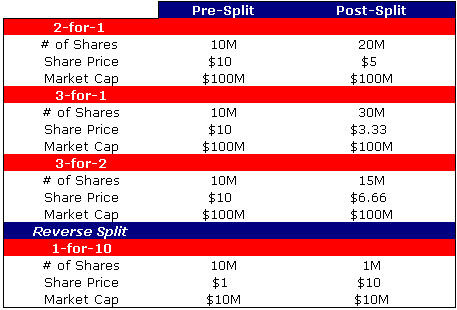Financial Leads Information 5
Want to make your marketing campaign a success?
Then you need to use financial sales leads that are customized for your specific industry.
Understanding Stock Splits
Say you had a $100 bill and someone offered you two $50 bills for it. Would you take the offer? This might sound like a pointless question, but the action of a stock split puts you in a similar position. In this article we will explore what a stock split is, why it’s done and what it means to the investor.
What Is a Stock Split?
A stock split is a corporate action that increases the number of the corporation’s outstanding shares by dividing each share, which in turn diminishes its price. The stock’s market capitalization, however, remains the same, just like the value of the $100 bill does not change if it is exchanged for two $50s. For example, with a 2-for-1 stock split, each stockholder receives an additional share for each share held, but the value of each share is reduced by half: two shares now equal the original value of one share before the split.
Let’s say stock A is trading at $40 and has 10 million shares issued, which gives it a market capitalization of $400 million ($40 x 10 million shares). The company then decides to implement a 2-for-1 stock split. For each share shareholders currently own, they receive one share, deposited directly into their brokerage account. They now have two shares for each one previously held, but the price of the stock is split by 50%, from $40 to $20. Notice that the market capitalization stays the same – it has doubled the amount of stocks outstanding to 20 million while simultaneously reducing the stock price by 50% to $20 for a capitalization of $400 million. The true value of the company hasn’t changed one bit.
The most common stock splits are, 2-for-1, 3-for-2 and 3-for-1. An easy way to determine the new stock price is to divide the previous stock price by the split ratio. In the case of our example, divide $40 by 2 and we get the new trading price of $20. If a stock were to split 3-for-2, we’d do the same thing: 40/(3/2) = 40/1.5 = $26.6.
It is also possible to have a reverse stock split: a 1-for-10 means that for every ten shares you own, you get one share. Below we illustrate exactly what happens with the most popular splits in regards to number of shares, share price and market cap of the company splitting its shares.

What’s the Point of a Stock Split?
So, if the value of the stock doesn’t change, what motivates a company to split its stock? Good question. There are several reasons companies consider carrying out this corporate action.
The first reason is psychology. As the price of a stock gets higher and higher, some investors may feel the price is too high for them to buy, or small investors may feel it is unaffordable. Splitting the stock brings the share price down to a more “attractive” level. The effect here is purely psychological. The actual value of the stock doesn’t change one bit, but the lower stock price may affect the way the stock is perceived and therefore entice new investors. Splitting the stock also gives existing shareholders the feeling that they suddenly have more shares than they did before, and of course, if the prices rises, they have more stock to trade.
Another reason, and arguably a more logical one, for splitting a stock is to increase a stock’s liquidity, which increases with the stock’s number of outstanding shares. You see, when stocks get into the hundreds of dollars per share, very large bid/ask spreads can result (see Why the Bid/Ask Spread Is So Important). A perfect example is Warren Buffett’s Berkshire Hathaway, which has never had a stock split. At times, Berkshire stock has traded at nearly $100,000 and its bid/ask spread can often be over $1,000. By splitting shares a lower bid/ask spread is often achieved, thereby increasing liquidity.
None of these reasons or potential effects that we’ve mentioned agree with financial theory, however. If you ask a finance professor, he or she will likely tell you that splits are totally irrelevant – yet companies still do it. Splits are a good demonstration of how the actions of companies and the behaviors of investors do not always fall into line with financial theory. This very fact has opened up a wide and relatively new area of financial study called behavioral finance (see Taking A Chance On Behavorial Finance).
Advantages for Investors
There are plenty of arguments over whether a stock split is an advantage or disadvantage to investors. One side says a stock split is a good buying indicator, signaling that the company’s share price is increasing and therefore doing very well. This may be true, but on the other hand, you can’t get around the fact that a stock split has no affect on the fundamental value of the stock and therefore poses no real advantage to investors. Despite this fact the investment newsletter business has taken note of the often positive sentiment surrounding a stock split. There are entire publications devoted to tracking stocks that split and attempting to profit from the bullish nature of the splits. Critics would say that this strategy is by no means a time-tested one and questionably successful at best.
Factoring in Commissions
Historically, buying before the split was a good strategy because of commissions that were weighted by the number of shares you bought. It was advantageous only because it saved you money on commissions. This isn’t such an advantage today because most brokers offer a flat fee for commissions, so you pay the same amount whether you buy 10 shares or 1,000 shares. Some online brokers have a limit of 2,000 or 5,000 shares for that flat rate, but most investors don’t buy that many shares at once. The flat rate therefore covers most trades, so it does not matter if you buy pre-split or post-split.
Conclusion
The most important thing to know about stock splits is that there is no effect on the worth (as measured by market capitalization) of the company. A stock split should not be the deciding factor that entices you into buying a stock. While there are some psychological reasons why companies will split their stock, the split doesn’t change any of the business fundamentals. In the end, whether you have two $50 bills or one $100 bill, you have the same amount in the bank.
For more detailed information on the topics below for our accredited email investor lists, visit the links using top of the page navigation menu.
exclusive:
We receive new investor names monthly and give a 180-day exclusive on each lead. We guarantee 100% that the sales leads are clean and “unhammered”.
100% satisfaction guarantee
Our leads are continuously cleaned and updated monthly in order to provide our clients with the cleanest, most accurate information possible on each investor. All of our investor leads are guaranteed to be 100% accurate. We will replace any record that is in error. 100% SATISFACTION GUARANTEED
pricing:
As a small company with low overhead, we are able to provide you with highly-qualified investors at very competitive prices. If you find a lower price, please let us know. We will beat any advertised price, just ask!
delivery:
We can E-mail your leads to you immediately, receive your leads within 1 hour, no shipping charges (for special orders delivery time may vary).
For any printed material (3×4 Cards, Paper, Mailing Labels) overnight delivery available upon request: UPS, FedEx, DHL, USPS
payment:
We accept the following payment methods: Visa, Master Card, AMEX, Discover, Company Check, Money Order, Cashiers Check, Wire Transfer, WesternUnion, Paypal.
To send money to us via Pay Pal please send your payments to: Info @ Investor Leads.com (without the spaces)
To contact our main office:
voice: 561-208-6060
fax: 877-315-4146
e-mail: info @ investor leads.com (please remove the extra spaces)
1438 W Lantana Rd Ste 275
Lantana, FL 33462



